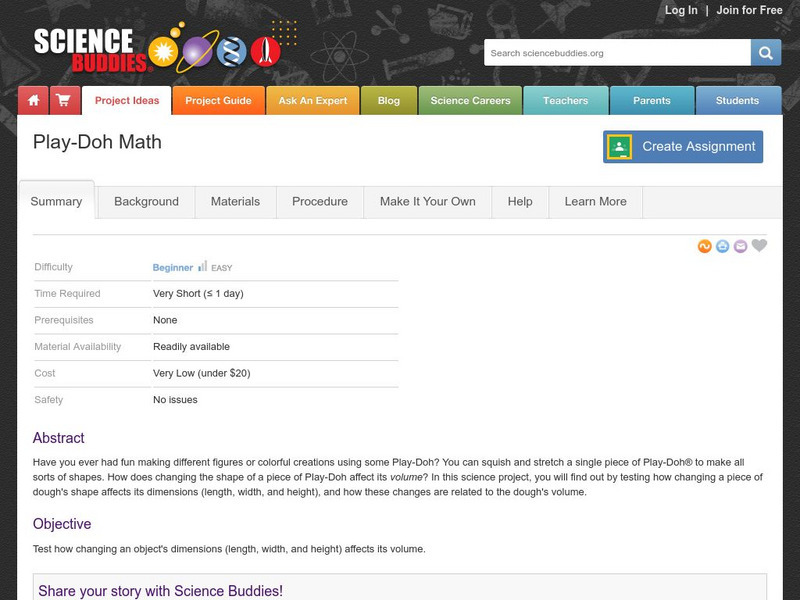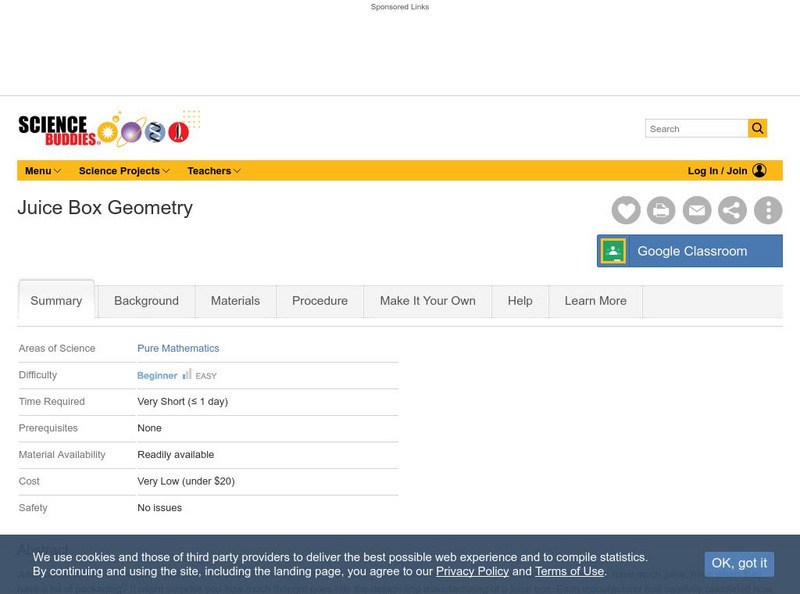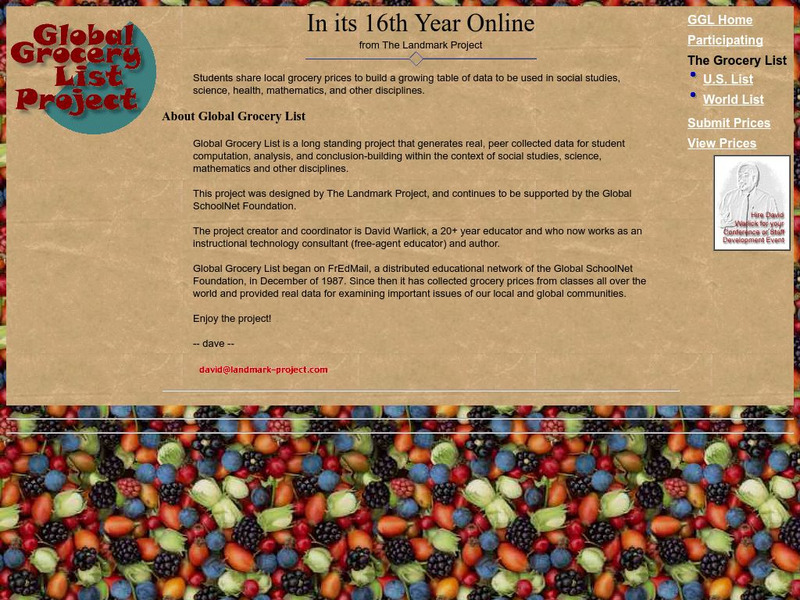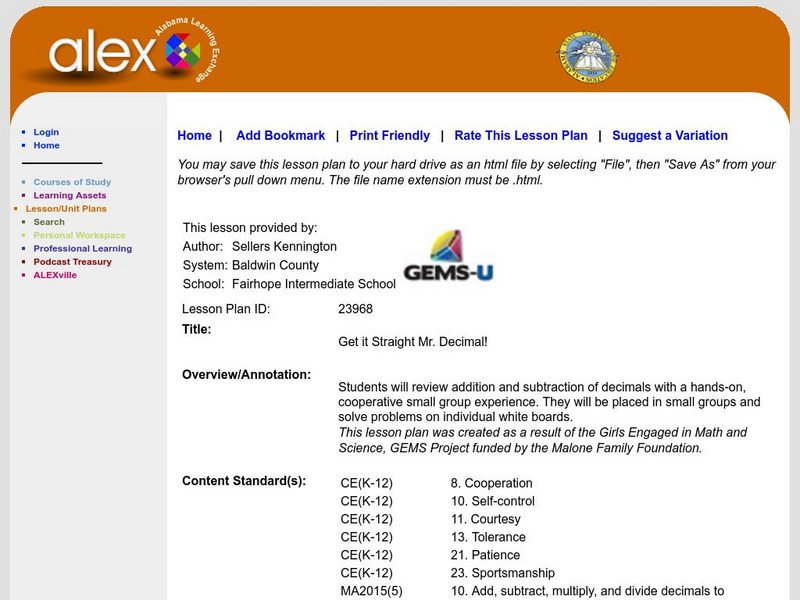Science Buddies
Science Buddies: Pick a Card, Any Card
No matter what your favorite card game is, we all wish we could use psychic powers to draw the card we want on our turn. You may not have psychic powers, but you might have the power of probability on your side. Do this experiment and...
Science Buddies
Science Buddies: Play Doh Math
One piece of Play-Doh can make many different shapes. Even though you can change the shape by squishing or stretching the Play-Doh, it is still the same size unless you add or take away some of the dough. Try this experiment to test how...
Science Buddies
Science Buddies: Juice Box Geometry
Juice boxes are so convenient, just poke the straw in and sip away. It might surprise you how much thought goes into the design and manufacturing of a juice box. Each manufacturer has carefully calculated how big each side should be to...
Science Buddies
Science Buddies: M&m Geometry
Geometry is the study of how to use math to describe and investigate different points, lines and shapes. The way that a shape is described in geometry is with a formula, which is simply a mathematical way to calculate different...
Science Buddies
Science Buddies: The Golden Rules of Photography
What is it that famous photographers do to make their images so pleasing to the eye? Find out if simple rules of geometry and symmetry can make you a better photographer.
Other
A River Runs Through It Learning Project
For this year long learning project integrating mathematics and science, students solve environmental problems using data collection and problem solving concepts. Designed for upper elementary gifted students. Interactive components and...
Center for Innovation in Engineering and Science Education, Stevens Institute of Technology
Ciese Collaborative Projects: Down the Drain: How Much Water Do You Use?
How much water do you use everyday? Find out in this engaging investigation, where you compare your water usage with your classmates and other people around the world. An exploration filled with lots of math and science that students are...
Other
Global Grocery List Project: Homepage
At this site from the Global Grocery List Project, students collect data on the prices of common grocery items and submit their findings. They can then compare the data they collected to data from students around the world. There are...
Alabama Learning Exchange
Alex: What's Your Guess? (Probability)
This lesson will allow the student to experience a series of informal comparisons, The student will explore the chances of various outcomes of an event. The student will use vocabulary associated with probability.This lesson plan was...
Alabama Learning Exchange
Alex: I'm Into Money!!!
Many students come to third grade needing to review and/or be retaught counting money and making change. This lesson will begin with a review of counting money. It will then introduce making change.This lesson plan was created as a...
Alabama Learning Exchange
Alex: Maybe Maybe Not
This is a beginning lesson on the concept of probability. Through a series of informal comparisons, the student will explore the chances of various outcomes of an event. The student will use vocabulary associated with probability.This...
Alabama Learning Exchange
Alex: Tulip Graphing
Young scholars will create an on-going graph using units of measurement correctly. This graph will represent the growth of a tulip (or other type of flower).This lesson plan was created as a result of the Girls Engaged in Math and...
Ducksters
Ducksters: Physics for Kids: Scalars and Vectors
Kids learn about scalars and vectors in the science of physics. Scalars are magnitude only while vectors have magnitude and direction. Examples and differences and how to draw a vector.
ClassFlow
Class Flow: Using Graphs
[Free Registration/Login Required] This flipchart contains a variety of graphs with internet links which can be beneficial to Science Project planning.
Alabama Learning Exchange
Alex: The Mean, Median, and Mode Chain Gang
Cooperative learning groups and chain links are used to find the mean, median, and mode. A Science NetLinks lesson is linked for further real-life application in the world of baseball (optional). This lesson plan was created as a result...
Alabama Learning Exchange
Alex: Get It Straight Mr. Decimal!
Students will review addition and subtraction of decimals with a hands-on, cooperative small group experience. They will be placed in small groups and solve problems on individual whiteboards. This lesson plan was created as a result of...
Alabama Learning Exchange
Alex: Lining Up the Decimals
This instructional activity provides a chance for the learners to order decimals from least to greatest and greatest to least. The numbers are based on a student's ability. This lesson plan was created as a result of the Girls Engaged in...
Alabama Learning Exchange
Alex: Time Flies
This lesson plan is one of the first in a unit on telling time which addresses the following content areas: language arts, math, science, social studies, and technology. Students will read several resource books to gather information....
Alabama Learning Exchange
Alex: My Favorite Number
The activity allows students to review many of the number theory concepts. Students will pick a composite number write verbal expressions about the number, find the factors, prime factorization, list multiples, draw a cartoon character...
Alabama Learning Exchange
Alex: Hanging Out With Prime Factorization
During this lesson, students will review factors, prime and composite numbers. Students will also create a mobile that show the prime factorization of the number of their choice. This lesson plan was created as a result of the Girls...
Alabama Learning Exchange
Alex: "Fantastic Fractions"
The young scholars will use sugar-free Gummy bears to identify fractional parts of the whole. The students will create a graph using the information obtain.This lesson plan was created as a result of the Girls Engaged in Math and Science...
Alabama Learning Exchange
Alex: "Ridin' Along in My Automobile"
Students will research prices of used cars to discover how automobiles lose their value over time. Students will create a chart to record their information, use their chart to graph their data, and find measures of central tendency of...
Alabama Learning Exchange
Alex: Ice Cream Sundae Survey
Learners quickly realize the importance of learning how to read and find information in charts, graphs, and tables compared to finding the same information written in a paragraph. This is a fun, high energy lesson!This lesson plan was...
Alabama Learning Exchange
Alex: Estimation Station
During this lesson, students will learn the difference between estimation and guessing. Knowing how to estimate is an essential skill that will help students determine approximate totals as well as check the reasonableness of their...
Other popular searches
- 4th Grade Science Project
- Physical Science Projects
- Science Project on Pulleys
- Science Project Volcano
- Science Project Gravity
- Science Project Ideas
- Forensic Science Project
- Science Fair Project Ideas
- Rock Science Project
- Science Project Food
- Science Project Terrarium
- Science Fair Project Data























